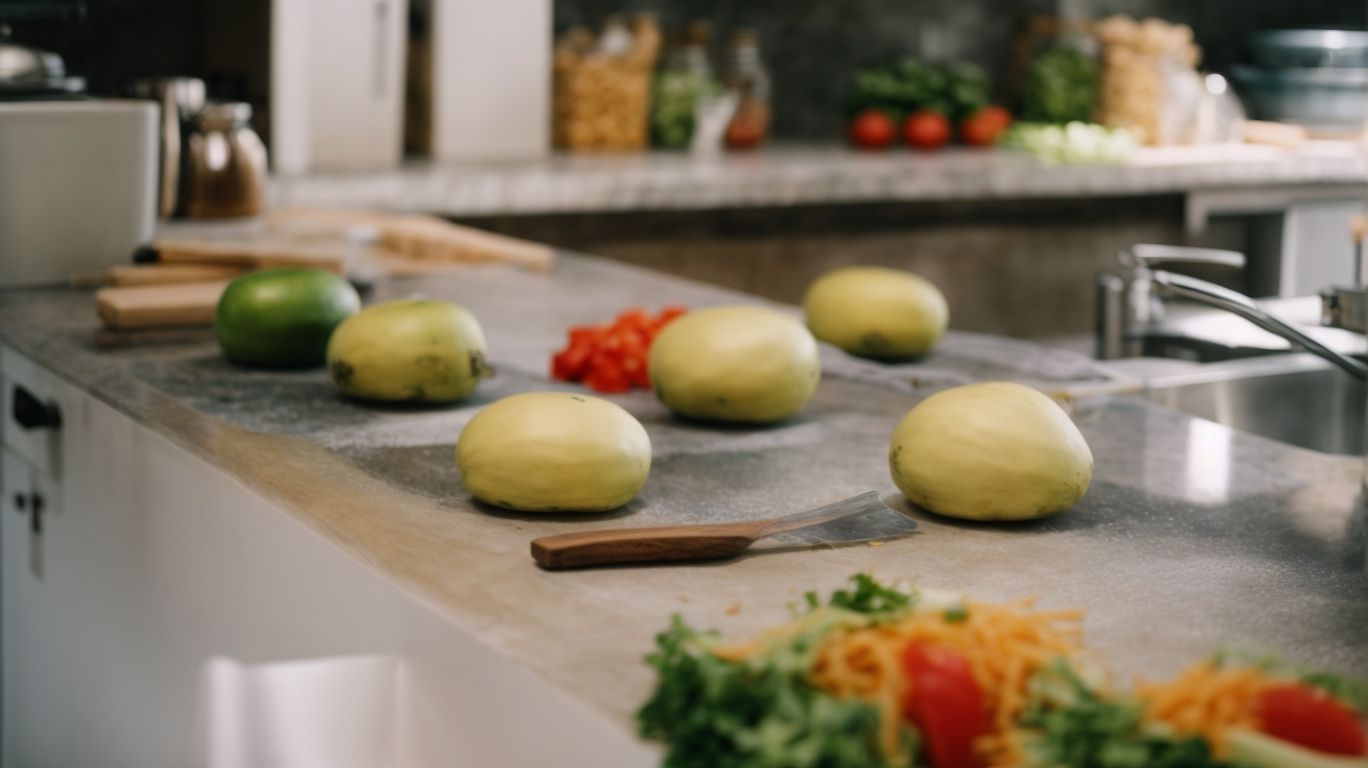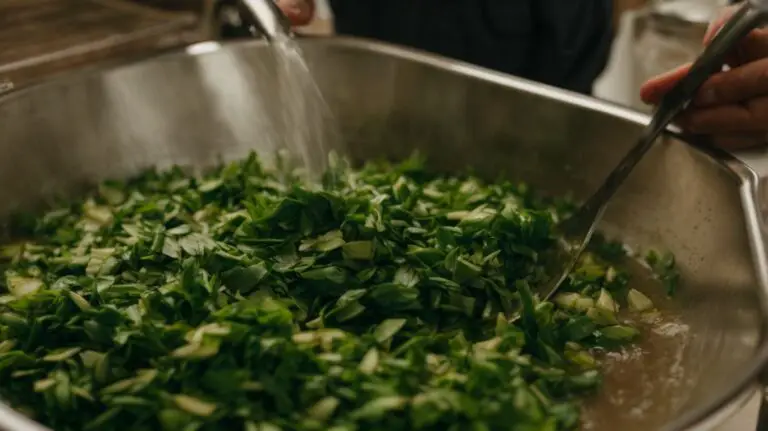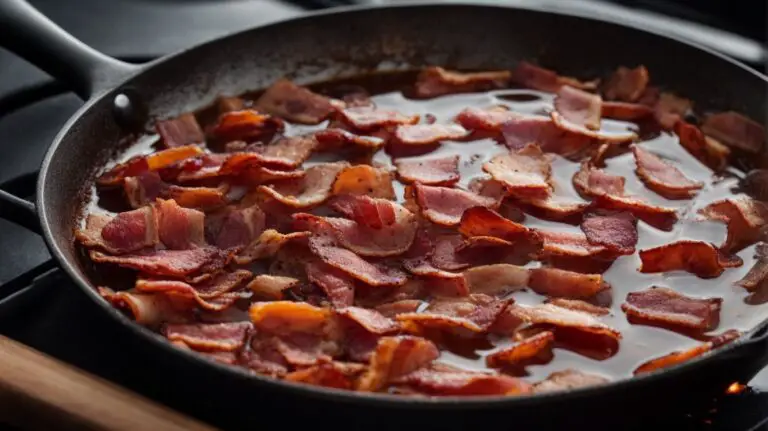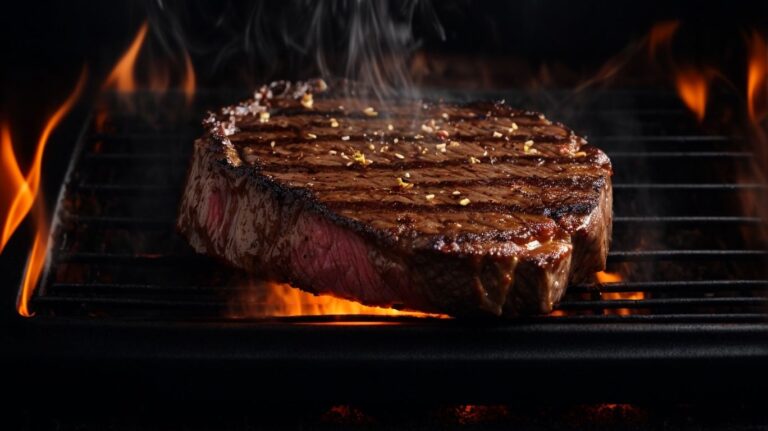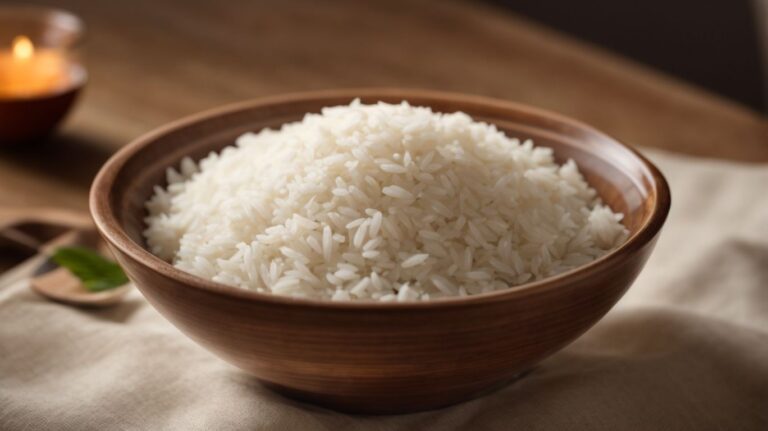How to Cook Jicama?
Have you ever tried jicama? This crunchy and slightly sweet root vegetable is a versatile ingredient that can be enjoyed in a variety of dishes.
From jicama fries to jicama slaw, there are endless possibilities when it comes to cooking with this nutritious veggie.
We’ll explore how to choose, store, prepare, and cook jicama, as well as the health benefits it offers.
Whether you’re a seasoned chef or just starting out in the kitchen, these tips and recipes will inspire you to get creative with jicama in your next meal.
Key Takeaways:
What Is Jicama?

Credits: Poormet.Com – Scott Carter
Jicama, also known as Mexican yam or Mexican turnip, is a root vegetable that belongs to the legume family and is native to Mexico.
This versatile tuberous root vegetable, with its crunchy texture and slightly sweet flavor, is widely used in various culinary traditions around the world. Jicama is believed to have its origins in Mexico and Central America, where it has been cultivated for centuries. It is commonly found in both round and elongated shapes, with its thick brown skin that needs to be peeled before consumption.
Jicama is an excellent source of dietary fiber, vitamin C, and potassium, making it a nutritious addition to salads, slaws, salsas, and stir-fries.
How To Choose Jicama?
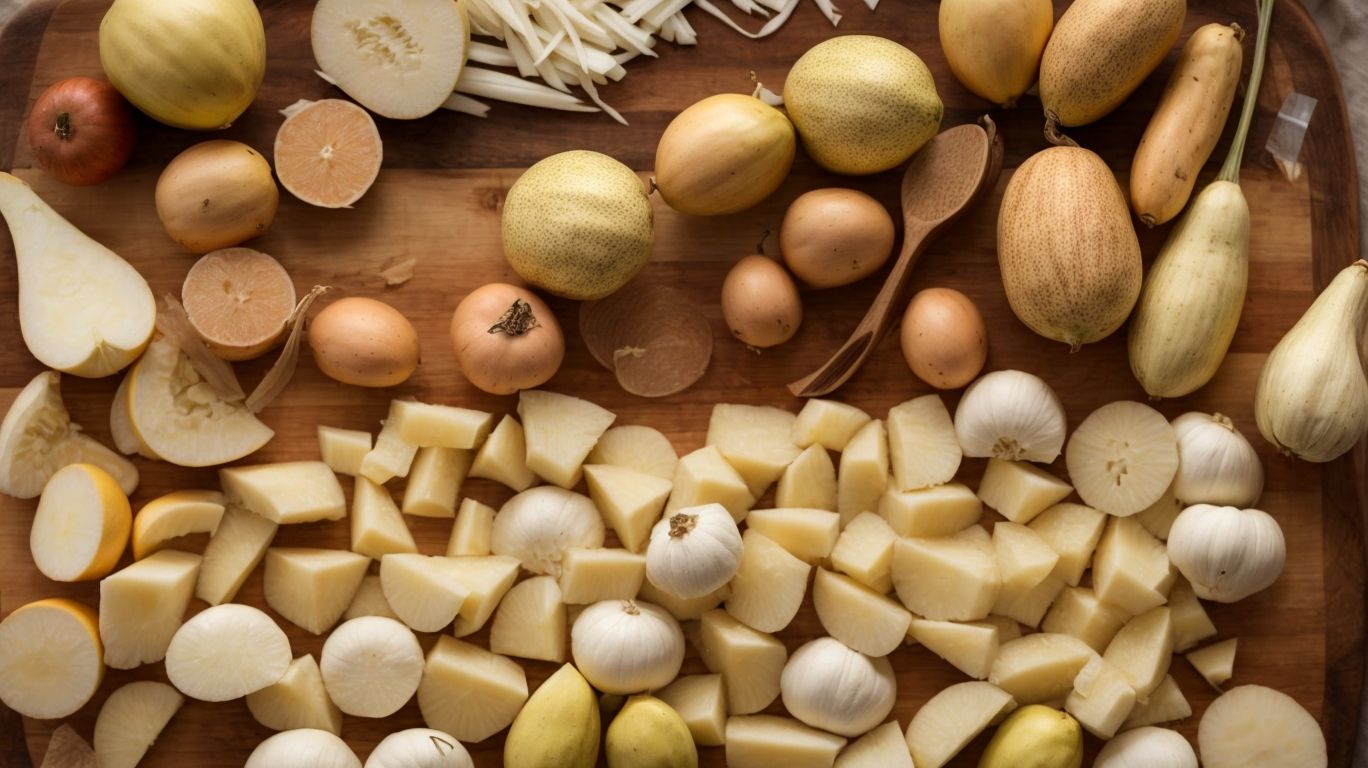
Credits: Poormet.Com – Ralph Thompson
Selecting the perfect jicama involves looking for firmness, smooth skin, and a heavy feel relative to its size.
When choosing ripe jicama, inspect the firmness of the vegetable by gently pressing it – a ripe jicama should feel solid without any soft spots. The skin should be smooth and free of bruises, blemishes, or wrinkling, indicating freshness. A ripe jicama tends to be heavier than it looks based on its size, suggesting it is juicier and more flavorful inside. Remember, these qualities are essential indicators of a prime jicama ready to be enjoyed in your culinary creations!
How To Store Jicama?
After purchasing jicama, store it in a cool, dry place away from sunlight to maintain its freshness and crispness.
When storing jicama, ensure it is kept in a well-ventilated area to prevent it from becoming too moist, which can lead to spoilage.
Avoid storing jicama near items with strong odors as it can absorb surrounding smells easily.
For extended freshness, consider wrapping the jicama in a paper towel before placing it in a breathable produce bag or container.
How To Prepare Jicama?
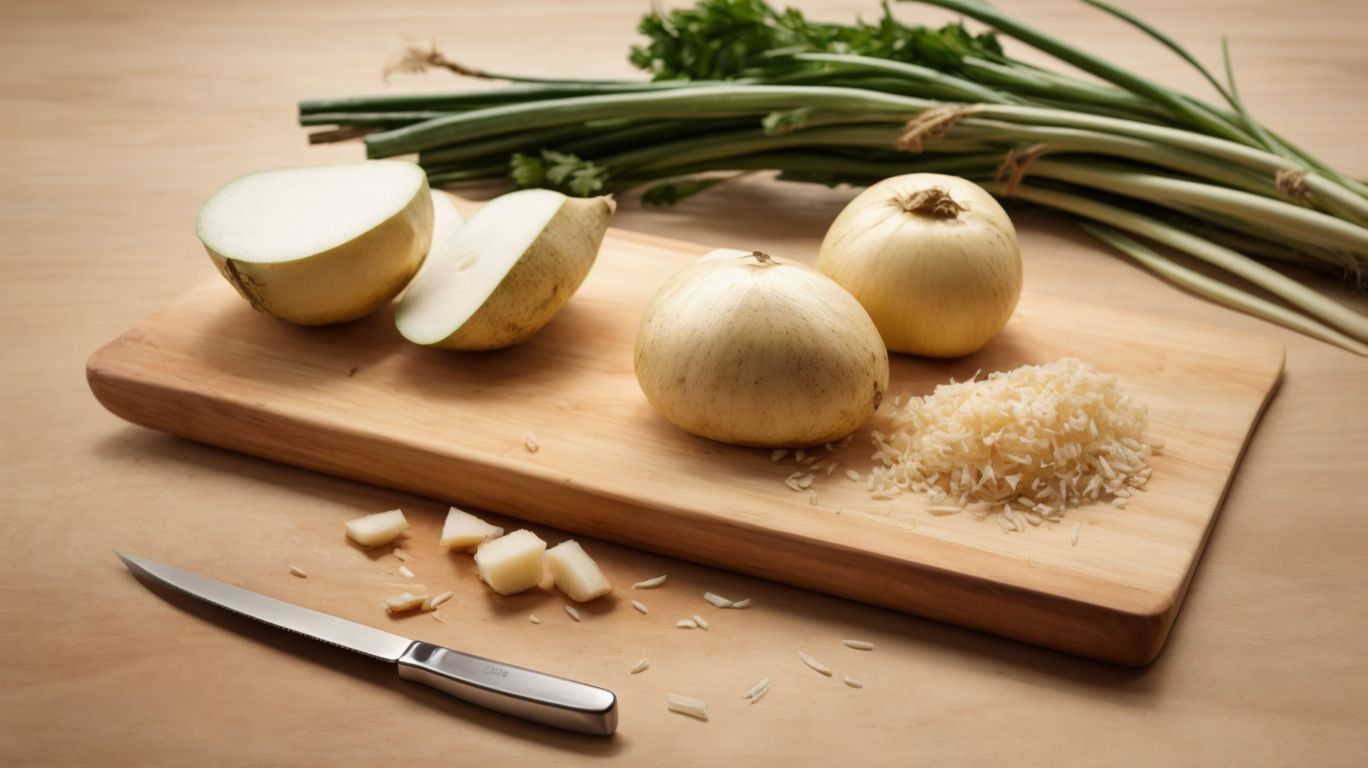
Credits: Poormet.Com – William King
Preparing jicama involves peeling and cutting it into desired shapes for various culinary applications.
In terms of preparing jicama, the first step is to wash the root thoroughly under cold running water to remove any dirt or debris. Once cleaned, using a sharp vegetable peeler, carefully peel off the thick brown skin to reveal the crisp white flesh underneath. After peeling, cut the jicama into slices, sticks, cubes, or even julienne strips, depending on the recipe you are preparing. It’s important to note that jicama can be enjoyed raw in salads, salsas, or slaws, or it can be cooked by boiling, roasting, or sautéing to add a unique crunch to your dishes.
Peeling Jicama
To peel jicama, use a sharp knife to remove the tough outer skin and reveal the crisp, white flesh beneath.
-
Begin by cutting off both ends of the jicama to create stable flat surfaces for cutting.
-
Then, stand the jicama upright on one end and carefully slice downwards to remove the skin in strips, following the curve of the vegetable.
It’s essential to work slowly and steadily to maintain control over the knife, ensuring a smooth peeling process without causing any accidents. Always remember to use a stable cutting board to prevent any slips or injuries while handling the jicama.
Cutting Jicama
When cutting jicama, ensure to slice it into uniform pieces or sticks for consistent cooking or serving.
Jicama is a versatile root vegetable that offers a refreshing crunch and a slightly sweet taste when consumed raw. By cutting it into uniform pieces, you can create a visually appealing platter for serving or incorporate it into salads, slaws, or stir-fries.
For a different presentation, consider cutting the jicama into matchsticks for a more delicate and manageable bite. The fibrous texture of jicama makes it ideal for absorbing a variety of flavors, whether marinated or seasoned with spices.
How To Cook Jicama?
Cooking jicama offers a versatile canvas for culinary creativity, whether baking in the oven for crispy fries or quickly microwaving for a tender side dish.
Jicama, with its mild flavor and crunchy texture, can be utilized in various cooking methods to bring out unique flavors. Sautéing jicama with a medley of spices can add depth to stir-fries, while grilling slices of jicama enhances its natural sweetness.
For a refreshing twist, try incorporating jicama into salads by shredding it into slaw or slicing it thinly for a crunchy element. Mixing jicama with citrus fruits and herbs creates a vibrant and flavorful salsa that pairs perfectly with grilled meats or fish.
Jicama Fries
Creating delicious jicama fries involves baking thinly sliced jicama sticks in the oven until perfectly crispy, seasoned with a blend of salt, garlic powder, and smoked paprika.
-
Once you have your jicama sticks sliced and seasoned to perfection, preheat the oven to 400°F (200°C) and line a baking sheet with parchment paper.
-
Arrange the jicama sticks on the baking sheet in a single layer, ensuring they have enough space between them to allow for even crisping.
-
Bake in the preheated oven for about 25-30 minutes, flipping the fries halfway through the cooking process to ensure they are crispy on all sides.
-
Once the jicama fries are golden brown and crispy, remove them from the oven and let them cool slightly before serving.
Jicama Slaw
Jicama slaw is a refreshing and crunchy salad made with julienned jicama, carrots, and a zesty dressing, ideal as a side dish for grilled chicken thighs or steak.
If you want to prepare this delicious slaw at home, you’ll need one medium jicama, two large carrots, a quarter cup of fresh cilantro leaves, and a dressing made from lime juice, olive oil, honey, and a dash of chili powder. Begin by peeling and julienning the jicama and carrots, then mix them together with the chopped cilantro in a large bowl. To make the dressing, whisk together the lime juice, olive oil, honey, and chili powder until well combined.
Next, drizzle the dressing over the jicama and carrot mixture and toss gently to ensure even coating. You can also customize the dressing by adding a hint of garlic or some apple cider vinegar for an extra kick. Refrigerate the slaw for at least thirty minutes before serving to allow the flavors to meld together. This jicama slaw is not only a feast for the taste buds but also a visually appealing addition to any meal, perfect for picnics, parties, or a simple weeknight dinner.
Jicama Chips
For a healthy snack alternative, try baking thinly sliced jicama rounds in the oven until they turn into crispy, flavorful chips seasoned with your favorite spices.
To make these delicious jicama chips, start by preheating your oven to 375°F (190°C). Wash the jicama thoroughly, peel off the tough outer skin, and then slice them into thin rounds using a mandoline slicer for uniform thickness. Place the jicama rounds in a bowl, drizzle with olive oil, sprinkle with salt, pepper, and any seasoning of your choice, such as paprika or garlic powder. Arrange the seasoned jicama slices on a parchment-lined baking sheet in a single layer to ensure even crisping. Bake for about 20-25 minutes, flipping halfway through until the chips are golden brown and crispy. Enjoy these flavorful jicama chips as a guilt-free snack or a crunchy side dish!
Jicama Stir-fry
Incorporate crunchy jicama sticks into a vibrant stir-fry with an array of colorful vegetables and aromatic spices for a flavorful and nutritious meal option.
When preparing this delightful dish, begin by cutting the jicama into thin sticks to offer a satisfying crunch in every bite. Combine the jicama with bell peppers, broccoli florets, snap peas, and thinly sliced carrots for a colorful medley of textures and flavors.
To enhance the essence of the stir-fry, consider using a blend of soy sauce, ginger, garlic, and sesame oil for a classic Asian-inspired seasoning. The combination of these ingredients will infuse the dish with a delightful umami taste while keeping the vegetables crisp and vibrant.
Jicama Salad
A refreshing jicama salad with a tangy dressing, crisp veggies, and a sprinkle of fresh herbs offers a delightful contrast of flavors and textures, perfect for a light meal or as a side dish.
When making a jicama salad, the key is to start with the star ingredient – jicama. This crunchy, slightly sweet root vegetable adds a unique crunch to the salad. To complement the jicama, consider adding colorful bell peppers, juicy cherry tomatoes, and thinly sliced red onions for a burst of flavor. For the dressing, lime juice mixed with a hint of honey or agave nectar provides a zesty sweetness that enhances the overall taste of the salad.
What Are The Health Benefits Of Jicama?
Jicama boasts a range of health benefits, being rich in essential nutrients, high in fiber, low in calories, and supportive of digestive health.
One of the key advantages of jicama lies in its nutrient profile. It is packed with vitamin C, essential for immune function and skin health, as well as potassium, important for heart health and muscle function. Its high fiber content promotes satiety, aids in digestion, and helps regulate blood sugar levels.
The caloric density of jicama is impressively low, making it a great choice for those looking to manage their weight or calorie intake. The fiber in jicama supports a healthy digestive system by promoting regular bowel movements and feeding beneficial gut bacteria.
Rich In Nutrients
Jicama is a nutrient powerhouse, packed with essential vitamins, minerals, and antioxidants that contribute to overall health and well-being.
One of the standout features of jicama is its impressive vitamin C content, which plays a crucial role in immune function and collagen production. Jicama is a good source of fiber, supporting digestive health and aiding in weight management.
This versatile root vegetable also contains potassium, an essential mineral for regulating blood pressure and muscle function. Jicama offers a unique combination of prebiotic compounds that promote the growth of beneficial gut bacteria, enhancing gut health.
High In Fiber
One notable health benefit of jicama is its high fiber content, which supports digestive health, promotes satiety, and aids in weight management.
Fiber plays a crucial role in maintaining a healthy digestive system. It helps prevent constipation by adding bulk to the stool, promoting regular bowel movements. This, in turn, supports the growth of beneficial gut bacteria, improving overall gut health.
The high fiber content in jicama can also help in managing weight. Fiber-rich foods like jicama increase feelings of fullness, reducing overeating and snacking between meals. This satiating effect contributes to weight management and can assist in controlling blood sugar levels, which is beneficial for metabolic health.
Low In Calories
Jicama stands out as a low-calorie food option, making it a suitable choice for individuals looking to manage their caloric intake while still enjoying delicious and satisfying meals.
Incorporating jicama into your diet offers a multitude of benefits beyond just its low caloric content. This root vegetable is rich in essential nutrients like vitamin C, fiber, and potassium, contributing to a nutrient-dense meal. Its versatility in the kitchen allows for endless culinary possibilities – whether enjoyed raw in salads for a refreshing crunch or cooked in stir-fries for added texture and flavor. The high water content in jicama also aids in hydration, making it a great choice for maintaining overall health and well-being.
Good For Digestive Health
Including jicama in your diet can promote digestive health due to its fiber content and beneficial nutrients that support gut function and overall well-being.
Jicama, also known as Mexican turnip, is not only a crispy and delicious addition to your meals but also provides a significant source of dietary fiber. This fibrous content aids in proper digestion by promoting regular bowel movements and preventing constipation. Jicama is rich in prebiotic fiber, which acts as fuel for the healthy bacteria in your gut, helping to maintain a balanced gut microbiome.
What Are Some Tips For Cooking With Jicama?
Enhance the flavor of jicama dishes by incorporating citrus juices, zesty spices, and complementary vegetables or protein options for a diverse and satisfying culinary experience.
When preparing jicama, consider experimenting with different citrus varieties such as lime, lemon, or orange to add layers of freshness and acidity to your dishes. These juices not only enhance the natural sweetness of jicama but also provide a tangy contrast.
For a burst of flavor, try incorporating zesty spices like cayenne pepper, chili powder, or smoked paprika into your jicama recipes. These spices can elevate the overall taste profile and offer a hint of heat that complements the crunchy texture of jicama.
To balance the flavors and textures, consider pairing jicama with vegetables like cucumbers, bell peppers, or tomatoes for a refreshing salad or stir-fry. Alternatively, you can combine jicama with grilled chicken, shrimp, or tofu to create a satisfying and protein-rich meal.
Use Citrus Or Spices To Enhance Flavor
Adding a splash of citrus juice or a sprinkle of aromatic spices can elevate the taste profile of jicama dishes, adding depth and complexity to your culinary creations.
In terms of citrus, the zesty acidity of lime or the sweet tanginess of orange can complement the crisp, refreshing nature of jicama perfectly. Similarly, the warm notes of cinnamon, the earthy undertones of cumin, or the fiery kick of chili powder can bring a whole new dimension to jicama salads, slaws, or salsas.
For a refreshing snack, try sprinkling jicama sticks with a mix of lime juice, chili powder, and a pinch of salt. These flavors not only enhance the natural sweetness of jicama but also add a burst of vibrant colors to your dish, making it visually appealing.
Using citrus and spices not only boosts the taste of jicama but also offers health benefits; citrus fruits are packed with vitamin C, while spices like turmeric or ginger bring anti-inflammatory and antioxidant properties to your meal. Experiment with different citrus varieties and spice blends to find your favorite jicama flavor combination and let your culinary creativity shine.
Blanch Jicama Before Cooking
Blanching jicama briefly in hot water before cooking can help soften its texture and reduce cooking time, ensuring a tender and palatable result in your dishes.
Blanching is a technique that involves immersing food briefly in boiling water, followed by rapid cooling. This process is particularly useful for jicama as it not only helps in texture modification but also retains its natural flavor by locking in its essence.
By blanching jicama, you can maintain its crispness while making it easier to incorporate into various recipes. Blanching aids in removing any lingering bitterness present in jicama, making it more appealing to the taste buds.
Pair With Other Vegetables Or Protein
Combining jicama with a variety of vegetables or protein sources can create balanced and nutritious meals, offering a blend of flavors, textures, and nutrients for a satisfying dining experience.
Pairing jicama with colorful bell peppers, crunchy cucumber, and creamy avocado can add a refreshing twist to salads or wraps, providing a mix of vibrant colors and contrasting tastes. Incorporating jicama into stir-fries with tofu or chicken introduces a satisfying crunch and subtle sweetness to the savory dishes, enhancing the overall mouthfeel and depth of flavors. By experimenting with different combinations, you can elevate the nutritional profile of your meals, infusing them with essential vitamins, minerals, and antioxidants while stimulating your taste buds with diverse textures and culinary creativity.
Frequently Asked Questions
What is jicama and how do I cook it?
Jicama is a root vegetable with a crunchy texture and slightly sweet taste. To cook it, peel the skin and cut into desired shapes before boiling or roasting.
Is jicama safe to eat raw?
Yes, jicama is safe to eat raw and is often enjoyed as a healthy snack. Just make sure to properly wash and peel the skin before consuming.
Can I substitute jicama for other vegetables in recipes?
Absolutely! Jicama can be used as a substitute in recipes that call for water chestnuts, potato, or even apples. Just keep in mind that the texture and taste may differ slightly.
How do I know when jicama is cooked?
Jicama is cooked when it is fork-tender and soft. The cooking time will vary depending on the method used, so it’s best to check for doneness periodically.
Can I freeze cooked jicama?
Yes, you can freeze cooked jicama for later use. Just make sure to cool it completely before storing it in an airtight container in the freezer. It can be kept for up to 3 months.
What are some creative ways to cook jicama?
Aside from boiling or roasting, jicama can also be used in stir-fries, salads, and even made into chips. Get creative and experiment with different seasonings and cooking methods to find your favorite way to cook jicama.

